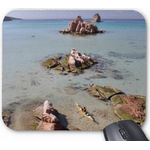Araucanía: Villarrica N. P.
This stage consists of a single but very complete and unforgettable day. We take a transport from Coñaripe, 750 feet above sea level. We relax at 2700 feet in the Geometric hot springs. We ride up the hill to cross the Villarrica National Park at 4000 feet through Araucaria forest and we rush down to Pucón in a downhill of more than 3000 feet.
Stage index:
Abril 20: April 20, 2011: From Coñaripe to Pucón (Profile)
April 20, 2011: From Coñaripe to Pucón
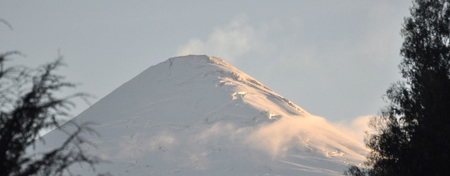 We load up the bikes to Ivan´s pickup, who will take us to the termas Geométricas. When we get there they are still closed and we wait in the sun until they open. The sky is clear above us, but clouds are approaching from the west.
We load up the bikes to Ivan´s pickup, who will take us to the termas Geométricas. When we get there they are still closed and we wait in the sun until they open. The sky is clear above us, but clouds are approaching from the west.
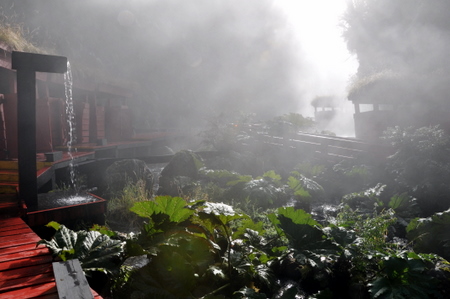 We are the first to go in and the only ones for a while. We have all the pools for us. The atmosphere of Geométricas hot springs is special. The water heated by the Villarrica volcano flows through a canyon 30 to 60 feet wide and 45 deep. The walls are covered with ferns and moss. Above the rim, the trees almost block the sunlight and leave only small gaps where the sun shines through when it is aligned with them. Along the ravine, an elevated wooden walkway gives access to all pools which are distributed on both sides. Once we put on our swimsuit, we start walking from the wider area of the canyon. Here the sun light enters in abundance and illuminates the huge leaves of the Nalcas. As we move down the aisle the hot vapor floating in the air blurs the objects. The walkway is more visible because it´s painted red. This color creates a strange feeling. Although in disagreement with the surrounding vegetation and dark rocks, provides a striking contrast of color. The design of this hot springs is very original. The walkway, for example, forms a broken line that fits the shape of the canyon. The booths for changing clothes are also painted in red and their roofs are covered with the same mosses and ferns as the walls. When we cross the zone of the hottest pools, the steam is so thick that visibility is reduced to a few yards. The sun slips through the canopy creating light beams in the steam giving the place a magical atmosphere. At the end of the corridor, the air is clearer and we discover the beginning of the canyon where a cold waterfall drops. We are amazed and wherever we look up, down, left and right is beautiful.
We are the first to go in and the only ones for a while. We have all the pools for us. The atmosphere of Geométricas hot springs is special. The water heated by the Villarrica volcano flows through a canyon 30 to 60 feet wide and 45 deep. The walls are covered with ferns and moss. Above the rim, the trees almost block the sunlight and leave only small gaps where the sun shines through when it is aligned with them. Along the ravine, an elevated wooden walkway gives access to all pools which are distributed on both sides. Once we put on our swimsuit, we start walking from the wider area of the canyon. Here the sun light enters in abundance and illuminates the huge leaves of the Nalcas. As we move down the aisle the hot vapor floating in the air blurs the objects. The walkway is more visible because it´s painted red. This color creates a strange feeling. Although in disagreement with the surrounding vegetation and dark rocks, provides a striking contrast of color. The design of this hot springs is very original. The walkway, for example, forms a broken line that fits the shape of the canyon. The booths for changing clothes are also painted in red and their roofs are covered with the same mosses and ferns as the walls. When we cross the zone of the hottest pools, the steam is so thick that visibility is reduced to a few yards. The sun slips through the canopy creating light beams in the steam giving the place a magical atmosphere. At the end of the corridor, the air is clearer and we discover the beginning of the canyon where a cold waterfall drops. We are amazed and wherever we look up, down, left and right is beautiful.
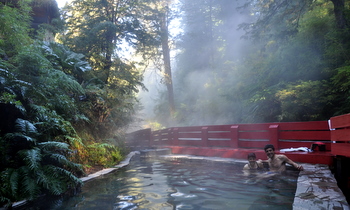 We start our way back soaking in all pools. 99 degrees, 102, 106. Our favorite: 106. In addition to the fantastic hot feeling, tiny cold water streams slide down from the ferns on the wall to pierce our necks like needles. The mystique is broken when the next visitors appear in the mist, but by then we have enjoyed the incredible atmosphere of the place. The air is cold and we dart like frightened mice from pool to pool to dive again and recover the skin warmth. When we get back to the entrance, we go back to the pool of 106 for a last dip.
We start our way back soaking in all pools. 99 degrees, 102, 106. Our favorite: 106. In addition to the fantastic hot feeling, tiny cold water streams slide down from the ferns on the wall to pierce our necks like needles. The mystique is broken when the next visitors appear in the mist, but by then we have enjoyed the incredible atmosphere of the place. The air is cold and we dart like frightened mice from pool to pool to dive again and recover the skin warmth. When we get back to the entrance, we go back to the pool of 106 for a last dip.
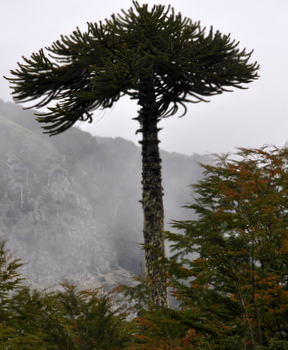 Before start pedaling and to avoid driving our nervous system crazy, we wait some time while eating at the quincho in the hot springs. What awaits us is a relentless climb up the hill. The road is in good conditions till the entrance of the park, but from here, the roots, fallen trees and streams make the road a fun obstacle test. Fortunately, most of the slopes are tolerable, even with loaded panniers. The clouds have completely covered the sky, so we ride in a dim light. The road enters into the Araucaria forest, a sacred tree to the Mapuche people, original inhabitants of this area. The araucaria looks primitive, like from Jurassic. In fact, they already existed in that geological time, when South America, Africa, Antarctica, India and Madagascar formed the supercontinent of Gondwana. Some have the bark formed by large plates. The young ones still have the trunk covered by hard and sharp leaves forming an upward spiral. The branches are a chain of leaves where each one comes from inside the predecessor. These trees have something special, perhaps because of the originality of its form. When we reached the pass, the fog surrounds us and we can see the silhouette of the araucarias against the whitish foggy blanket.
Before start pedaling and to avoid driving our nervous system crazy, we wait some time while eating at the quincho in the hot springs. What awaits us is a relentless climb up the hill. The road is in good conditions till the entrance of the park, but from here, the roots, fallen trees and streams make the road a fun obstacle test. Fortunately, most of the slopes are tolerable, even with loaded panniers. The clouds have completely covered the sky, so we ride in a dim light. The road enters into the Araucaria forest, a sacred tree to the Mapuche people, original inhabitants of this area. The araucaria looks primitive, like from Jurassic. In fact, they already existed in that geological time, when South America, Africa, Antarctica, India and Madagascar formed the supercontinent of Gondwana. Some have the bark formed by large plates. The young ones still have the trunk covered by hard and sharp leaves forming an upward spiral. The branches are a chain of leaves where each one comes from inside the predecessor. These trees have something special, perhaps because of the originality of its form. When we reached the pass, the fog surrounds us and we can see the silhouette of the araucarias against the whitish foggy blanket.
The road downhill requires more technical skills and we are glad to be crossing the park in the direction from South to North. Now not only the slope is steeper, but the ruts are much deeper. But we are going down, so the fun continues. As we lose elevation, the araucaria density decreases and they are replaced by other species. By the time we leave the park, the forest has lost its charm. The track conditions improve substantially and now we can ride at full speed down the mountain. Half way down we stop to visit El Salto de la China, a waterfall about 150 feet high in a short detour from the road. After a quick Japanese-style visit, we return back to the road to continue downhill at full speed.
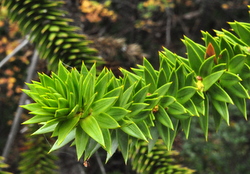 The slope gradually becomes smooth. When we get to the paved road that will lead us to Pucón, we cannot even notice the drop. It begins to get dark, the traffic is considerable and we are still 13 mi from the city. We peed up our pace to reach our destination sooner. About 4 mi from Pucón we find the pleasant surprise of the existence of a bike path that allows us to relax the pace. In the tourist office we meet Patricio, Philippe´s father, who along with his mother Mónica run the Ruka Pucón hostel. Over the next few days we enjoy their hospitality and keep long conversations on topics ranging from our adventures to Philippe´s future plans.
The slope gradually becomes smooth. When we get to the paved road that will lead us to Pucón, we cannot even notice the drop. It begins to get dark, the traffic is considerable and we are still 13 mi from the city. We peed up our pace to reach our destination sooner. About 4 mi from Pucón we find the pleasant surprise of the existence of a bike path that allows us to relax the pace. In the tourist office we meet Patricio, Philippe´s father, who along with his mother Mónica run the Ruka Pucón hostel. Over the next few days we enjoy their hospitality and keep long conversations on topics ranging from our adventures to Philippe´s future plans.
In short, one very varied day with a good mix of relaxation, physical effort and fun and a good dose of adrenaline. Highly, highly recommended.
Go to top
© 2014 Explore Pangea. All Rights Reserved. Website
Terms
of Use.







